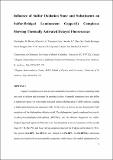Files in this item
Influence of sulfur oxidation state and substituents on sulfur-bridged luminescent copper(I) complexes showing thermally activated delayed fluorescence
Item metadata
| dc.contributor.author | Brown, Christopher | |
| dc.contributor.author | Li, Chenfei | |
| dc.contributor.author | Carta, Veronica | |
| dc.contributor.author | Li, Wenbo | |
| dc.contributor.author | Xu, Zhen | |
| dc.contributor.author | Stroppa, Pedro | |
| dc.contributor.author | Samuel, Ifor D. W. | |
| dc.contributor.author | Zysman-Colman, Eli | |
| dc.contributor.author | Wolf, Michael | |
| dc.date.accessioned | 2020-05-21T23:36:08Z | |
| dc.date.available | 2020-05-21T23:36:08Z | |
| dc.date.issued | 2019-06-03 | |
| dc.identifier | 258978967 | |
| dc.identifier | e119d3c2-c2a6-4f2b-a637-aef09c469a7c | |
| dc.identifier | 85066802939 | |
| dc.identifier | 000470332200006 | |
| dc.identifier.citation | Brown , C , Li , C , Carta , V , Li , W , Xu , Z , Stroppa , P , Samuel , I D W , Zysman-Colman , E & Wolf , M 2019 , ' Influence of sulfur oxidation state and substituents on sulfur-bridged luminescent copper(I) complexes showing thermally activated delayed fluorescence ' , Inorganic Chemistry , vol. 58 , no. 11 , pp. 7156-7168 . https://doi.org/10.1021/acs.inorgchem.8b03500 | en |
| dc.identifier.issn | 0020-1669 | |
| dc.identifier.other | ORCID: /0000-0001-7183-6022/work/62668447 | |
| dc.identifier.uri | https://hdl.handle.net/10023/19982 | |
| dc.description | C.M.B. thanks Dr. Maria B. Ezhova for helpful discussions regarding NMR spectra, and Dr. Saeid Kamal for assistance with the TCSPC data. C.M.B. and M.O.W. acknowledge the Natural Sciences and Engineering Research Council of Canada (NSERC) and the Peter Wall Institute for Advanced Studies for financial support and the Laboratory for Advanced Spectroscopy for Imaging Research (LASIR) for facilities access. Z.X. thanks Compute Canada for computing resources for DFT calculations. C.L. thanks the Prof. & Mrs. Purdie Bequests Scholarship and AstraZeneca PhD Studentship. E.Z.-C. and I.D.W.S thank EPSRC (grants EP/R035164/1 and EP/L017008/1) for financial support. | en |
| dc.description.abstract | Copper(I) complexes are seen as more sustainable alternatives to those containing metal ions such as iridium and platinum for emitting devices. Copper(I) complexes have the ability to radiatively decay via a thermally activated delayed fluorescence (TADF) pathway, leading to higher photoluminescent quantum yields. In this work we discuss six new heteroleptic Cu(I) complexes of the diphosphine–diimine motif. The diphosphine ligands employed are (oxydi- 2,1-phenylene)bis(diphenylphosphine) (DPEPhos) and the diimine fragments are sulfur- bridged dipyridyl ligands (DPS) which are functionalized at the 6,6′-positions of the pyridyl rings (R = H, Me, Ph), and have varying oxidation states at the bridging sulfur atom (S, SO2). The proton ( Cu-DPS, Cu-DPSO2 ) and phenyl ( Cu-Ph-DPS, Cu-Ph-DPSO2 ) substituted species are found to form monometallic complexes, while those with methyl substitution ( Cu-Me-DPS, Cu-Me-DPSO2 ) are found to have a “Goldilocks” degree of steric bulk leading to bimetallic species. All six Cu(I) complexes show emission in the solid state, with the photophysical properties characterized by low temperature steady-state and time-resolved spectroscopies and variable temperature time-correlated single photon counting (TCSPC). Cu- DPS , Cu-DPSO2 , Cu-Me-DPS , Cu-Me-DPSO2 and Cu-Ph-DPSO2 were shown to emit via a TADF mechanism, while Cu-Ph-DPS showed photoluminescence properties consistent with triplet ligand-centered (3LC) emission. | |
| dc.format.extent | 2794453 | |
| dc.language.iso | eng | |
| dc.relation.ispartof | Inorganic Chemistry | en |
| dc.subject | QD Chemistry | en |
| dc.subject | DAS | en |
| dc.subject.lcc | QD | en |
| dc.title | Influence of sulfur oxidation state and substituents on sulfur-bridged luminescent copper(I) complexes showing thermally activated delayed fluorescence | en |
| dc.type | Journal article | en |
| dc.contributor.sponsor | EPSRC | en |
| dc.contributor.sponsor | EPSRC | en |
| dc.contributor.institution | University of St Andrews. School of Chemistry | en |
| dc.contributor.institution | University of St Andrews. Organic Semiconductor Centre | en |
| dc.contributor.institution | University of St Andrews. EaSTCHEM | en |
| dc.contributor.institution | University of St Andrews. School of Physics and Astronomy | en |
| dc.contributor.institution | University of St Andrews. Centre for Biophotonics | en |
| dc.contributor.institution | University of St Andrews. Condensed Matter Physics | en |
| dc.identifier.doi | https://doi.org/10.1021/acs.inorgchem.8b03500 | |
| dc.description.status | Peer reviewed | en |
| dc.date.embargoedUntil | 2020-05-22 | |
| dc.identifier.grantnumber | EP/R035164/1 | en |
| dc.identifier.grantnumber | ep/l017008/1 | en |
This item appears in the following Collection(s)
Items in the St Andrews Research Repository are protected by copyright, with all rights reserved, unless otherwise indicated.

